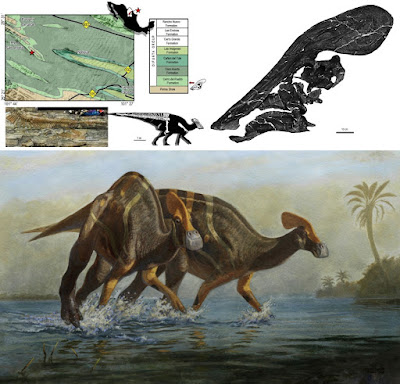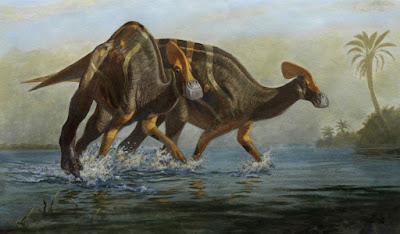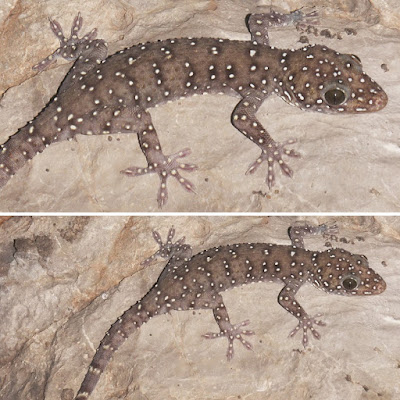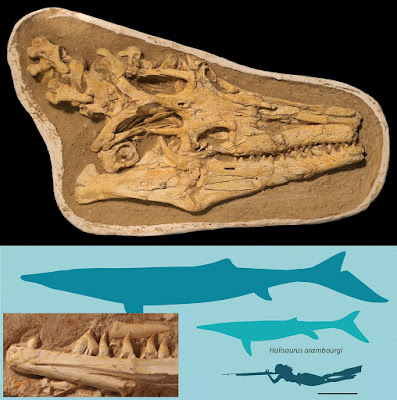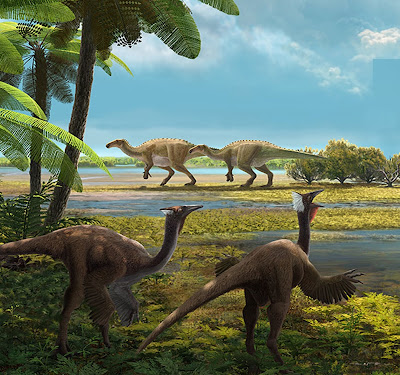[Most Recent Entries] [Calendar View]
Wednesday, May 12th, 2021
| Time | Event | ||||
| 5:01a | [Paleontology • 2021] Tlatolophus galorum • A Parasaurolophini Dinosaur (Hadrosauridae: Parasaurolophini) from the upper Campanian of the Cerro del Pueblo Formation, Coahuila, northern Mexico
ABSTRACT In 2013, a joint team of INAH and UNAM paleontologists launched a project to recover a semi-articulated tail of a putative hadrosaur, that was discovered in 2005, on the superficial upper Campanian deposits of the Cerro del Pueblo Formation, near Presa de San Antonio, General Cepeda Municipality, Coahuila, northern Mexico. Currently, this specimen is the most complete lambeosaurine so far found in Mexico. Herein, Tlatolophus galorum gen. et sp. nov. is erected based on features shown in the head of this specimen. The distinctive characters of this new species are the skull high, with a length/height ratio equals to 1.79; the premaxilla wide, in which maximum/minimum width ratio is about 2.4; the maxillary ascending ramus has a low dorsal apex; the pterygoid dorsal crest is high and convex; the supracranial crest is high, spatula-shaped and similar to an inverse-comma; the occipital condyle is inclined 56° ventrally; the supraoccipital crest is laminar, wide and located inside a deep nuchal fossa; the squamosal shelf is moderately long, as long as the foramen magnum diameter; the dorsal margins of the infratemporal fenestra and orbit are located at the same level; and the nasal is elongated, caudally expanded, and bilobed. The phylogenetic analysis performed here recovers Tlatolophus within the Tribe Parasaurolophini; in this result, the supracranial crest spatula-shaped of this new parasaurolophini represent a plesiomorphic condition within the tribe. Keywords: Coahuila, Hadrosauridae, Parasaurolophini, supracranial crest, Mexico
Ángel A. Ramírez-Velasco, Felisa J. Aguilar, René Hernández-Rivera, José Luis Gudiño Maussán, Marisol Lara Rodríguez and Jesús Alvarado-Ortega. 2021. Tlatolophus galorum, gen. et sp. nov., A Parasaurolophini Dinosaur from the upper Campanian of the Cerro del Pueblo Formation, Coahuila, northern Mexico. Cretaceous Research. 104884, In Press.DOI: 10.1016/j.cretres.2021.104884 | ||||
| 9:37a | [Herpetology • 2021] Gekko (Gekko) pradapdao • A New Cave-dwelling Gekko (Squamata, Gekkonidae) from Lopburi Province, central Thailand
Abstract We describe Gekko pradapdao sp. nov. from Tham Khao Chan (Khao Chan Cave), Tha Luang District, Lopburi Province, in central Thailand. The new species, a member of the subgenus Gekko, differs from all currently recognized Gekko species by the following combination of morphological characters and pattern: maximal known snout-vent length of 127.1 mm, lack of contact between nostrils and rostral, 24–28 interorbital scales between supraciliaries, 89–91 scale rows around midbody, 16–18 dorsal tubercle rows at midbody, 30–34 ventral scale rows at midbody, 11–13 precloacal pores in males, a single postcloacal tubercle on each side of the base of the tail, 13–16 subdigital lamellae on 1st toe and 17–19 on 4th toe, no Y-shaped mark on head, non-banded dorsal pattern on a dark chocolate brown to black background, and a dark brown iris. Urgent actions should be taken to evaluate the conservation status of the new species. Keywords: Reptilia, Gekko pradapdao sp. nov., taxonomy Worawitoo Meesook, Montri Sumontha, Nattasuda Donbundit and Olivier S. G. Pauwels. 2021. A New Cave-dwelling Gekko (Gekko) from Lopburi Province, central Thailand (Squamata, Gekkonidae). Zootaxa. 4969(2); 318–330. DOI: 10.11646/zootaxa.4969.2.5 ตุ๊กแกประดับดาว Starry Tokay Gecko Gekko(Gekko) pradapdao Meesook, Sumontha, Donbundit & Pauwels, 2021 สัตว์เฉพาะถิ่นเขาหินปูน พบเฉพาะภาคกลางของประเทศไทย ... ด้วยลักษณะสีตัวที่สีน้ำตาลเข้ม-ดำ และมีจุดประสีขาวกระจายทั่วตัว จึงเป็นที่มาของชื่อวิทยาศาสตร์ที่มาจากภา | ||||
| 10:03a | [Paleontology • 2021] Pluridens serpenti • A New Mosasaurid (Mosasauridae: Halisaurinae) from the Maastrichtian of Morocco and Implications for Mosasaur Diversity
Abstract Mosasaurids (Mosasauridae) were specialized marine lizards that evolved and radiated in the Late Cretaceous. Their diversity peaked in the Maastrichtian, with the most diverse faunas known from Morocco. Here we describe a new species of mosasaurid from this fauna. Pluridens serpentis sp. nov. is described based on two complete skulls and referred jaws. It is referred to Pluridens based on the elongate and robust jaws, small teeth, and specialized tooth implantation. Pluridens is referred to Halisaurinae based on the posteriorly expanded premaxilla, long premaxilla-maxilla suture, broad premaxillary facet on the maxilla, closed otic notch, and small, striated, hooked teeth. The orbits are reduced relative to other halisaurines while the snout is robust and flat with a broad, rounded tip. The jaws bear numerous small, hooked, snake-like teeth. Skulls imply lengths of 5-6 meters; referred material suggests lengths of ≥10 meters. Pluridens’ specialized morphology – especially the contrasting large size and small teeth - suggests a distinct feeding strategy. Small orbits imply that P. serpentis relied on nonvisual cues including touch and chemoreception during foraging, as in modern marine snakes. Numerous neurovascular foramina on the premaxillae are consistent with this idea. The small teeth suggest proportionately small prey. The dentary becomes massive and robust in the largest individuals, suggesting sexual selection and perhaps sexual dimorphism, with the mandibles possibly functioning for combat as in modern beaked whales and lizards. The new mosasaur emphasizes how Maastrichtian mosasaurids were characterized by high species richness, functional diversity of niches occupied, and a certain degree of endemism, i.e. geographic specialization. and continued diversifying until the end of the Cretaceous, just prior to the K-Pg extinction. Keywords: Squamata, Mosasauridae, Halisaurinae, Marine reptiles, Maastrichtian, Paleobiogeography Nicholas R. Longrich, Nathalie Bardet, Fatima Khaldoune, Oussama Khadiri Yazami and Nour-Eddine Jalil. 2021. Pluridens serpentis, A New Mosasaurid (Mosasauridae: Halisaurinae) from the Maastrichtian of Morocco and Implications for Mosasaur Diversity. Cretaceous Research. In Press, 104882. DOI: 10.1016/j.cretres.2021.104882 | ||||
| 10:23a | [Paleontology • 2021] Pelecanimimus polyodon (Ornithomimosauria: Macrocheiriformes) • Postcranial Anatomy and the Evolution of the Specialized Manus in Ornithomimosaurs and Sternum in Maniraptoriforms
Abstract Pelecanimimus polyodon was discovered in 1993 in the Spanish Barremian fossil site of Las Hoyas, being the first ornithomimosaur described from Europe. So far, there has been no detailed description of the holotype of Pelecanimimus, which is composed of the anterior-half of an articulated skeleton. Here we report a new, detailed, revised and more accurate osteological description of its postcranial skeleton, comparing this new data to information about Ornithomimosauria from the last three decades. This osteological and phylogenetic analysis of Pelecanimimus shows several ornithomimosaur synapomorphies and a unique combination of characters that emend its original diagnosis. Pelecanimimus diverged early in Ornithomimosauria and reveals an enlargement trend of the manus, shared with derived ornithomimosaurians, due to a long metacarpal I and elongated distal phalanges. This evolutionary novelty, and other synapomorphies, has led to the definition of a new clade, Macrocheiriformes, including Pelecanimimus and more derived ornithomimosaurs. Pelecanimimus has the only ossified sternal plates among ornithomimosaurs and the first evidence of uncinate processes in a non-maniraptoran theropod, indicating a convergent appearance of these structures in Coelurosauria. The character combination in an early-diverging ornithomimosaur like Pelecanimimus found in this analysis provides a key step in the evolution of the manus and pectoral girdle in Ornithomimosauria. Keywords: Early Cretaceous, Las Hoyas, osteology, phylogeny, Spain  Elena Cuesta, Daniel Vidal, Francisco Ortega, Masateru Shibata and José L. Sanz. 2021. Pelecanimimus (Theropoda: Ornithomimosauria) Postcranial Anatomy and the Evolution of the Specialized Manus in Ornithomimosaurs and Sternum in Maniraptoriforms. Zoological Journal of the Linnean Society. zlab013. DOI: 10.1093/zoolinnean/zlab013 |
| << Previous Day |
2021/05/12 [Calendar] |
Next Day >> |
